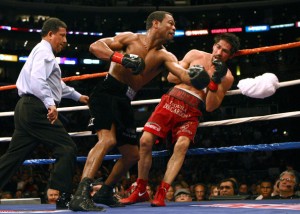By Kevin Iole, Yahoo! Sports
 Antonio Margarito had his boxing license revoked by the California State Athletic Commission in February after his trainer inserted an illegal knuckle pad that contained traces of Plaster of Paris into his hand wraps before a fight against Shane Mosley on Jan. 24 at the Staples Center in Los Angeles.
Antonio Margarito had his boxing license revoked by the California State Athletic Commission in February after his trainer inserted an illegal knuckle pad that contained traces of Plaster of Paris into his hand wraps before a fight against Shane Mosley on Jan. 24 at the Staples Center in Los Angeles.
Fortunately for Margarito, Mosley’s trainer, Naazim Richardson, suspected something was amiss and demanded that Margarito’s hands be rewrapped. Richardson’s insistence led to the discovery of the potentially lethal pad.
Had the illegal pad not been discovered, Mosley could have been seriously injured and Margarito could have had his next 25 years much like Luis Resto has lived his past 25, in agony over what had occurred in the ring.
Resto is the middling one-time junior middleweight contender who had an ounce of the stuffing pulled out of each of his eight-ounce gloves and his hand wraps tampered with before a June 16, 1983 fight in New York’s Madison Square Garden with unbeaten prospect Billy Collins Jr.
Resto and trainer Panama Lewis were each convicted of assault, conspiracy and criminal possession of a deadly weapon. Lewis was also convicted of tampering with a sports contest and both men were banned from sanctioned boxing for life, though Lewis still trains fighters in Florida.
Producer/director Eric Drath was long intrigued by the case and its aftermath and has produced a brilliant documentary, “Assault in the Ring,” which will begin airing on HBO on Aug. 1.
Collins died in an auto accident not long after the brutal, and highly unexpected, loss to Resto, a tragic end to a highly promising career. Collins was a charismatic and good-looking boxer who had an entertaining style that attracted fans by the droves.
Collins was promoted by Bob Arum of Top Rank, who knew a future star when he saw one. Arum was convinced that once Collins got past the lightly regarded Resto, a world title was in his future.
“Man, he was tremendous,” Arum said in the film. “He was a great-looking kid. He had all the moves. He punched like a mule. I mean, if this kid can make it through [the Resto fight], we have a gold mine here.”
Instead, what Collins got was a frightful beating and permanently blurred vision.
Randy Gordon, who at the time was the editor of The Ring magazine and would go on to become chairman and executive officer of the New York State Athletic Commission, was in Los Angeles preparing for a television broadcast on the day of the Collins-Resto fight.
He was walking through the Los Angeles International Airport when he was paged with a phone call. It was Ben Sharav, a New York attorney who at the time was shooting photographs for Ring.
Sharav told Gordon about the fight and about the allegations that the gloves had been tampered with. Gordon suggested that Sharav call Collins in the morning to arrange to have photographs taken.
The attorney did as he was instructed and took a now-famous shot of Collins’ battered and grotesquely swollen face. Gordon was pleased from a journalistic standpoint, though he indicated to Sharav that he wished Sharav had asked Collins to open his eyes for the photograph.
“He said, ‘His eyes were open,’ ” Gordon recalled. “The beating he took was unthinkable.”
Resto, whom Drath met in a New York gym after his release from prison, intrigued Drath. Resto was a soft-spoken sort who had steadfastly denied knowing anything had been done to his gloves or his hand wraps.
Drath, a former producer at CNN and FOX, opted to produce a film from Resto’s point of view.
“When I first met him, I found a tortured soul who was struggling every day with what had occurred and who lived with these whispers behind his back, if you will, that he’d murdered Billy Collins,” Drath said.
Drath does a masterful job not only of telling the story of the fight, but of its impact upon Resto and his family. Resto was living in near-squalor in a dungeon-like apartment, in New York apart from his wife and sons when he first met with Drath.
The personal relationship Drath built with Resto paid dividends because Resto opens up in the documentary and reveals facts about the night and what had gone on in his locker room that he had never before shared.
Among the many revelations Resto makes is that Lewis crushed a pill used to treat asthma and put it in his water bottle. The effect, Resto said, “was to open up the lungs” and allow him to get more oxygen in the latter stages of a fight.
Drath also stumbled upon many well-known trainers, who told him it was common for plaster to be put on fighters’ knuckles. Drath didn’t include that in the documentary that will be on HBO, but he did include it in the extras on the DVD that will be released in September.
Not long after the fight, Gordon did a television spot in which he showed how quickly the horsehair that was used to fill the gloves in those days could be removed from the gloves with a sharp instrument and quick fingers.
“Even with an inspector watching you, hovering over you, all you had to do was watch for an opportunity where you had just a couple of seconds and it could be done,” Gordon said.
He said it took him nine seconds a glove to stab a pair of scissors into the palm of a glove and yank out enough padding to turn the glove from a piece of athletic equipment into a weapon.
“You know, even if you have a guy really concentrating and paying close attention, 18 seconds isn’t a lot of time and if there’s even the smallest little distraction, like the guy sneezes or has to blow his nose, that’s plenty of time to get it done,” Gordon said.
Lewis declined to immediately glove Resto when the commission inspector assigned to his locker room ordered Resto to be gloved. The inspector stuck his head out the door and called for Jack Prenderville, the commission chairman. When the inspector returned, Lewis said he was ready to comply.
Lewis had a bad reputation in boxing circles even before the Collins-Resto fight said Jerry Izenberg, the wonderful sports columnist for the Newark Star-Ledger who was ringside for the bout.
Lewis was widely suspected of having tampered with the water he was giving to Aaron Pryor in his 1982 fight with the late Alexis Arguello, though nothing was ever proven and Lewis was never charged with a crime or accused of breaking a rule in that fight by the Florida Athletic Commission.
“There are a lot of low people in boxing, but even they would look down at him,” Izenberg said of Lewis.
Though Collins was getting beaten unmercifully, Izenberg said none of the reporters watching the fight from ringside initially suspected anything.
“It seemed inconceivable that anyone would pull the padding from the gloves with an inspector right there,” Izenberg said.
But when the fight ended and Collins Sr. went to shake hands with Resto, he realized the padding was missing. He shouted for help. Izenberg and several of his colleagues began to shout at athletic commission officials, urging them to grab the gloves.
Drath’s storytelling is marvelous and he intricately details the plot, the execution and its aftermath.
He brings Resto to Nashville, Tenn., to apologize to Collins Sr., and he flies him to Florida to confront Lewis.
It’s an emotionally charged film, but the saddest aspect is that more than a quarter of a century later, little has changed in boxing. Some trainers still try to alter the hand wraps in order to give their fighters an edge.
And the fighters, much like Resto, continue to plead ignorance.
If those fighters or those trainers who resort to such despicable tactics in order to win a sporting contest were to watch Drath’s marvelously done film, and see the pain it has caused Resto, let alone Collins, that alone might be the impetus for change.
Kevin Iole covers boxing and mixed martial arts for Yahoo! Sports. Click Here to read his Archive.

